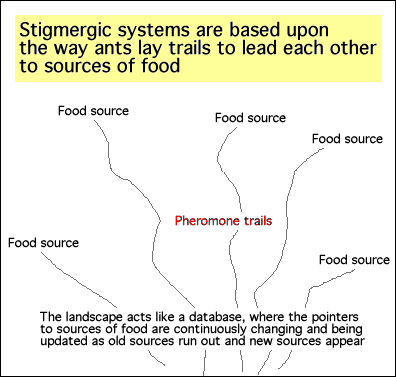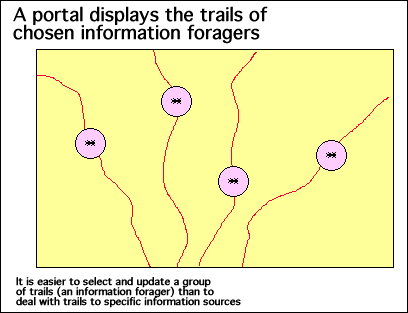

Stigmergy - the system employed by insects
Ant pheromone trails
Ants use a very efficient means of telling each other where they have found food by laying pheromone trails. Known as stigmergy, this method treats the landscape as a virtual database, which is carrying pointers to sources of food.
The remarkable characteristic of this system is that there is no overall control or organization: all the ants act independently. They are free to explore the terrain and leave trails when they have made valuable discoveries (see figure 1).

Figure 1
There is no necessity for ants to make judgements on which are the best trails to follow because the system is self-updating through a process of evaporation. Pheromone trails evaporate after a short time if they are not re-enforced. This ensures that the trail patterns continually adjust to the current locations of available sources of food. If a food source becomes exhausted, the trails leading to it quickly disappear.
Copying the ants
This same idea of laying trails to sources food is used in stigmergic systems - except that humans lay trails to sources of information in the form of bits and bytes in a computer memory rather than as pheromones left on the ground.
The main difference though, is that a human system needs to be able to discriminate between different trails. To an ant, food is food and no distinction has to be made as to the type or quality of the food. Information, on the other hand, is subject to relevance, accuracy, subjective judgement and whether or not the information is up-to date. Simply leaving trails isn't very efficient as most trails will lead to unsuitable information. This is illustrated in figure 2.

Figure 2 - a confusing plethora of trails
To overcome this problem, the trails are observed through portals, where human judgement can be brought into play to select only trails that lead to useful information sources. This filtering process is illustrated in figure 3.
Note: as the value and relevance of information is subjective and dependent upon its application, there needs to be many different portals to cover a variety of different needs.

Figure 3 - filtering the trails
By suitably filtering out all the surplus and redundant trails, a portal is able to display just a small sub-set of trails, which are suited to the needs of a particular sub-set of people. This is illustrated in figure 4.

Figure 4 - displaying a sub-set of trails
Overcoming the problem of selection
Clearly, if there are many people, each laying many trails to various sources of information, it could represent a major problem to decide which trails to display. This problem is solved by the portals selecting particular information providers, rather than individual trails.
As illustrated in figure 5, this is like selecting to follow the trails of a few chosen ants, rather than trying to examine the trails of the whole colony.

Figure 5 - selecting individuals rather than trails
In other words, It is far easier to make judgements on the information providers than it is to make judgements on a vast number of individual sources of information.

Figure 6 - portals display the trails of selected information providers
By selecting according to the quality of information providers, rather than the information itself, a portal can rapidly update and improve the overall quality of the information it is pointing to, simply by changing the providers. More than this, the scope and range of the information can be altered simply by making appropriate replacements.
The overall effect is to provide a low cost, dynamically changing information source that is constantly adapting to new developments in a highly competitive and volatile environment.
Note: this article covers only the superficial aspect of stigmergy. To appreciate how this situation leads to evolutionary growth and emergent self-organization, read through some of the articles in 'Technical notes' and 'References' .